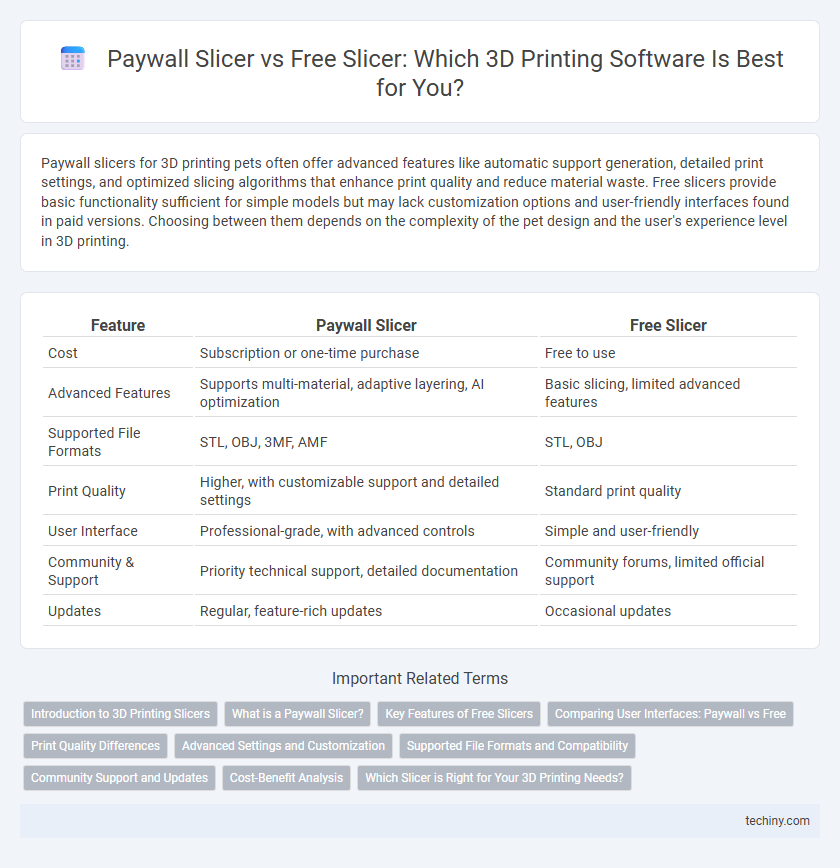Paywall slicers for 3D printing pets often offer advanced features like automatic support generation, detailed print settings, and optimized slicing algorithms that enhance print quality and reduce material waste. Free slicers provide basic functionality sufficient for simple models but may lack customization options and user-friendly interfaces found in paid versions. Choosing between them depends on the complexity of the pet design and the user's experience level in 3D printing.
Table of Comparison
| Feature | Paywall Slicer | Free Slicer |
|---|---|---|
| Cost | Subscription or one-time purchase | Free to use |
| Advanced Features | Supports multi-material, adaptive layering, AI optimization | Basic slicing, limited advanced features |
| Supported File Formats | STL, OBJ, 3MF, AMF | STL, OBJ |
| Print Quality | Higher, with customizable support and detailed settings | Standard print quality |
| User Interface | Professional-grade, with advanced controls | Simple and user-friendly |
| Community & Support | Priority technical support, detailed documentation | Community forums, limited official support |
| Updates | Regular, feature-rich updates | Occasional updates |
Introduction to 3D Printing Slicers
3D printing slicers convert digital 3D models into instructions for printers, determining print quality and material use efficiency. Paywall slicers offer advanced features like adaptive slicing and optimized support structures, enhancing precision and reducing print time. Free slicers provide essential tools suitable for beginners, supporting basic customization and a wide range of printer compatibility.
What is a Paywall Slicer?
A paywall slicer is a 3D printing software that requires users to purchase a license or subscription to access advanced features, enhanced print settings, and optimized slicing algorithms. These slicers often provide improved support generation, customizable print parameters, and integration with premium 3D printers, resulting in higher quality prints and faster processing times. Common examples include Simplify3D and PrusaSlicer Pro, which offer exclusive tools not available in free slicers like Cura or Slic3r.
Key Features of Free Slicers
Free slicers for 3D printing offer essential features such as customizable print settings, support generation, and basic model repair tools that efficiently prepare designs for fabrication. These open-source or no-cost tools often support a wide range of printer models and filament types, making them accessible and versatile for hobbyists and professionals alike. User-friendly interfaces and active community support enhance the usability and continual improvement of free slicers, positioning them as reliable options for cost-effective 3D printing workflows.
Comparing User Interfaces: Paywall vs Free
Paywall slicers in 3D printing often provide a polished, intuitive user interface designed for professionals seeking advanced features and streamlined workflows, with customizable settings and real-time previews enhancing user control. Free slicers typically offer a more basic, functional interface that caters to beginners and hobbyists, though some open-source options have made significant strides in user experience and feature sets. Comparing the two, paywall slicers tend to prioritize ease of use and efficiency through refined UI elements, while free slicers balance accessibility with flexibility, appealing to diverse user skill levels.
Print Quality Differences
Paywall slicers often offer advanced algorithms and proprietary features that enhance print quality by optimizing layer adhesion and minimizing defects, resulting in smoother surfaces and finer details. Free slicers, while improving steadily, typically lack some of these high-end optimization tools, which can lead to less precise prints, especially on complex models. Users seeking professional-grade print quality often prefer paywall slicers for their consistent and superior output.
Advanced Settings and Customization
Paywall slicers for 3D printing often offer advanced settings and customization options that enable precise control over layer height, print speed, and support structures, which can significantly enhance print quality and efficiency. Free slicers provide essential customization features but may lack the deep parameter tuning and specialized algorithms found in paid versions. Users seeking high-detail prints or unique material profiles typically benefit from the extensive configurability and frequent updates characteristic of paywall slicer software.
Supported File Formats and Compatibility
Paywall slicers typically support a wider range of file formats such as STL, OBJ, AMF, and 3MF, offering enhanced compatibility with various 3D modeling software. Free slicers often handle common formats like STL and OBJ but may lack support for advanced or proprietary file types, limiting workflow flexibility. Compatibility with diverse printers and firmware is generally more extensive in paywall slicers, providing smoother integration and fewer errors across multiple 3D printing devices.
Community Support and Updates
Paywall slicers typically offer dedicated customer support, regular software updates, and access to exclusive features tailored to professional users, ensuring enhanced reliability and performance for 3D printing projects. Free slicers benefit from active open-source communities that contribute to ongoing development, bug fixes, and feature additions, fostering rapid innovation and customization options. Users weighing paywall versus free slicers should consider the trade-off between official support and frequent community-driven improvements to match their project needs.
Cost-Benefit Analysis
Paywall slicers often provide advanced features such as optimized print settings, better support structures, and integrated cloud services that enhance print quality and efficiency. Free slicers, while cost-effective, may lack some high-end functionalities and require more manual adjustments, potentially increasing failure rates and material waste. Evaluating the cost-benefit involves weighing upfront software expenses against long-term savings in print time, material usage, and improved output consistency.
Which Slicer is Right for Your 3D Printing Needs?
Choosing the right slicer for your 3D printing needs depends on features, ease of use, and compatibility. Paywall slicers often provide advanced tools like automatic support generation, customizable print profiles, and expert technical support, which can enhance print quality and efficiency. Free slicers such as Cura or PrusaSlicer offer robust functionality and community-driven updates, making them ideal for hobbyists and budget-conscious users seeking reliable performance without extra cost.
Paywall Slicer vs Free Slicer Infographic

 techiny.com
techiny.com